Statistics: Hire a Divorce Attorney for the Best Custody Outcome
Study shows parents most likely to settle, share custody when both have attorney (+ other stats)
Though attorneys have a reputation for wanting to fight in court, a survey of recently divorced parents found that cases in which both parents had attorneys were the most likely to settle out of court. They were the most likely to end with parents sharing physical custody, as well.
If you're co-parenting, you may want to try Custody X Change. It helps you keep track of your schedule, calculate your parenting time and write a parenting plan. Make my schedule and plan now.
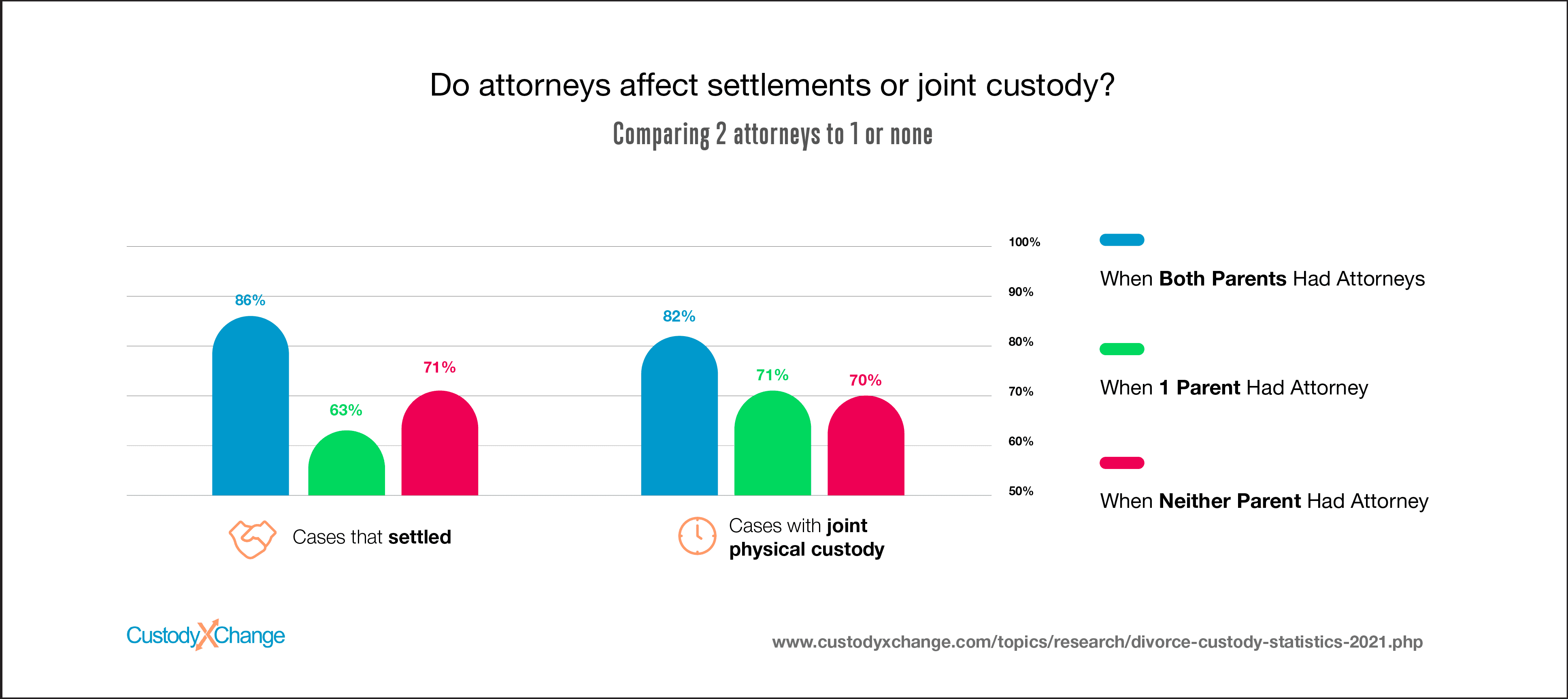
Download: PNG | JPG; Use image with attribution
The study also found that low-income parents were less likely than other parents to have a lawyer or receive joint custody. In addition, these parents tended to have worse ongoing relationships with their former spouses, and their children tended not to adjust as well.
Custody X Change questioned 1,000 U.S. adults who finalized a divorce involving child custody in the past two years. It used the Pollfish survey platform, and the margin of error was 4%. Download the survey results spreadsheet.
"It seems that when both parents have attorneys, the attorneys encourage their clients to reach a co-parenting agreement rather than go to trial," said Ben Coltrin, Custody X Change cofounder and president. "That's important for parents to consider as they decide whether to hire a lawyer."
Coltrin added that more research is needed to show cause and effect between any factors in the study. Still, he said, "the information is enlightening because data on child custody cases is hard to come by."
Attorneys and custody outcomes
Having both parents represented by a lawyer racked up costs. In such cases, survey respondents reported spending a median of $18,000 on the divorce and custody process — more than twice the median they spent (nearly $8,000) when they were the only represented parent, and 36 times the median they spent ($500) when neither parent was represented.
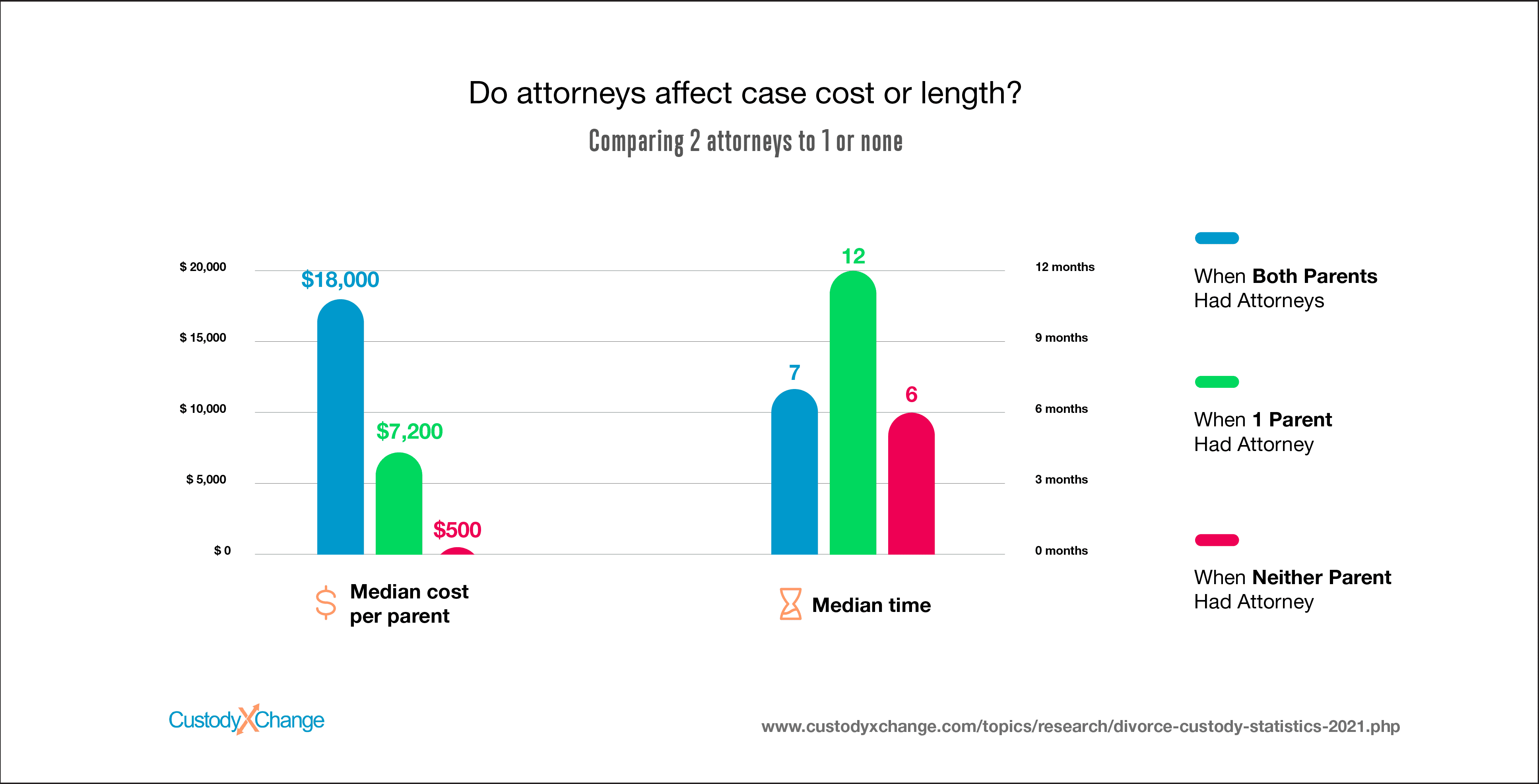
Download: PNG | JPG; Use image with attribution
However, the increased price tag came with advantages. Eighty-six percent of cases with both parents represented reached a settlement, which courts and legal experts consider the ideal outcome for most families. On the other hand, only 63% of cases with one attorney and 71% of cases with no attorneys reached settlement.
Two-attorney cases also resulted in joint physical custody at the highest rate — 82%. Cases with one parent represented and cases with neither parent represented both ended in joint custody about 70% of the time. This is meaningful because child experts consider joint physical custody — in which a child spends significant time with each parent — best for children, except in rare instances.
More data on legal representation
| Respondents who had attorneys | Respondents who didn't have attorneys |
|---|---|
| 74% extremely or moderately satisfied with case outcome | 59% extremely or moderately satisfied with case outcome |
| 19% low-income | 40% low-income |
| 86% college-educated (including technical college) | 67% college-educated (including technical college) |
Having only one parent represented was tied to unique challenges.
These cases were the least likely to settle.
They also took a median of one year to finalize (from the start of negotiations to the issuance of final orders), compared to a seven-month median for cases with two attorneys and a six-month median for cases with no attorney representation.
Interestingly, single-lawyer cases cost respondents several thousand dollars regardless of which parent had the lawyer. Respondents still spent a median of almost $6,000 on the legal process if only their former spouse had a lawyer.
Incomes and custody outcomes
The Custody X Change study also showed that parents with low incomes face unique challenges in divorce and custody cases.
Just 65% of these parents had a lawyer, whereas 84% of other parents did.
Similarly, 68% of low-income parents received joint physical custody — less than the 81% for respondents with medium or high income levels.
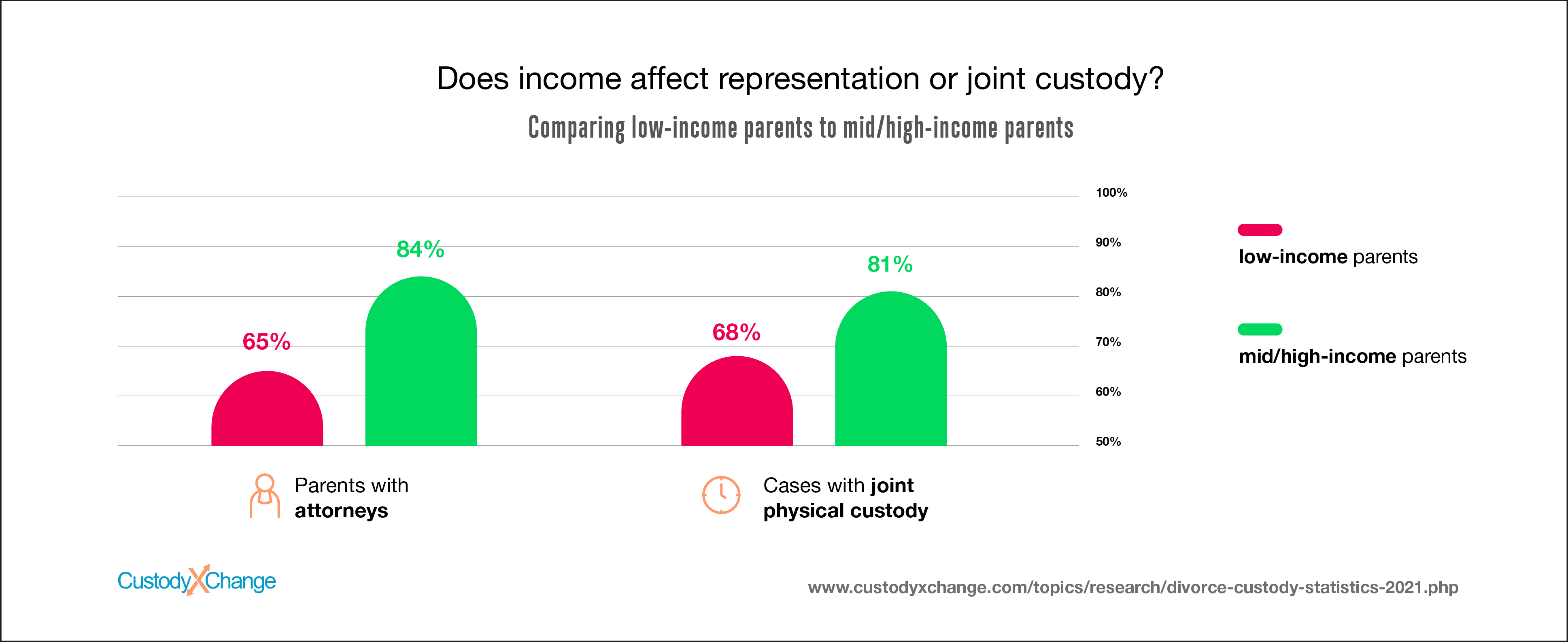
Download: PNG | JPG; Use image with attribution
Thirty percent of low-income parents reported getting along with their former spouse extremely or very well now, compared to 48% for other income levels.
The lower relationship rating may be tied to the fact that fewer low-income parents used alternative dispute resolution (ADR) methods, such as mediation. Most ADR methods focus on helping parents communicate with each other. Overall, parents who used ADR were almost twice as likely to rate their relationship highly following the divorce.*
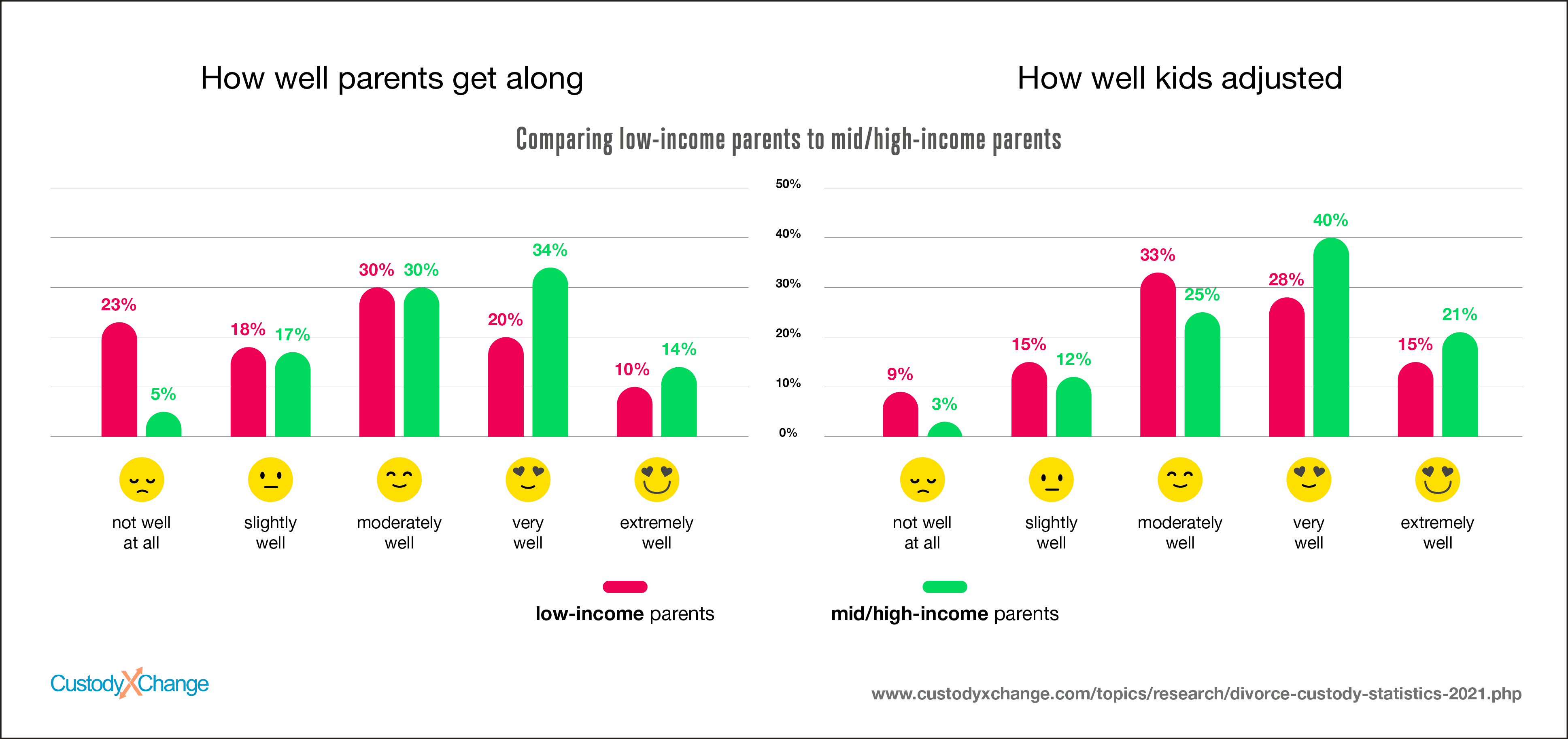
Download: PNG | JPG; Use image with attribution
Disparity extended to children of low-income parents. Only 43% of respondents with a low income said their kids adjusted extremely or very well following the divorce, while 61% of other parents said so.
More data on income
| Low-income respondents | Middle- or high-income respondents |
|---|---|
| 82% used alternative dispute resolution methods (e.g., mediation) | 97% used alternative dispute resolution methods (e.g., mediation) |
| Median time of 6 months | Median time of 9 months |
| $4,500 median cost | $16,320 median cost |
Though middle- and high-income parents had little variation between them, 12% more high-income parents said their kids adjusted extremely or very well (68% versus 56%).
Other divorce and custody findings
Overall, 79% of survey respondents had a lawyer. Seventy percent of those people were satisfied with their lawyer.
Most parents seemed pleased with their experience. Just more than half of parents gave the legal process a positive rating ("better than I ever imagined" or "good"), and roughly the same amount said their kids adjusted extremely or very well. Over 70% of respondents were extremely or moderately satisfied with their case outcome.
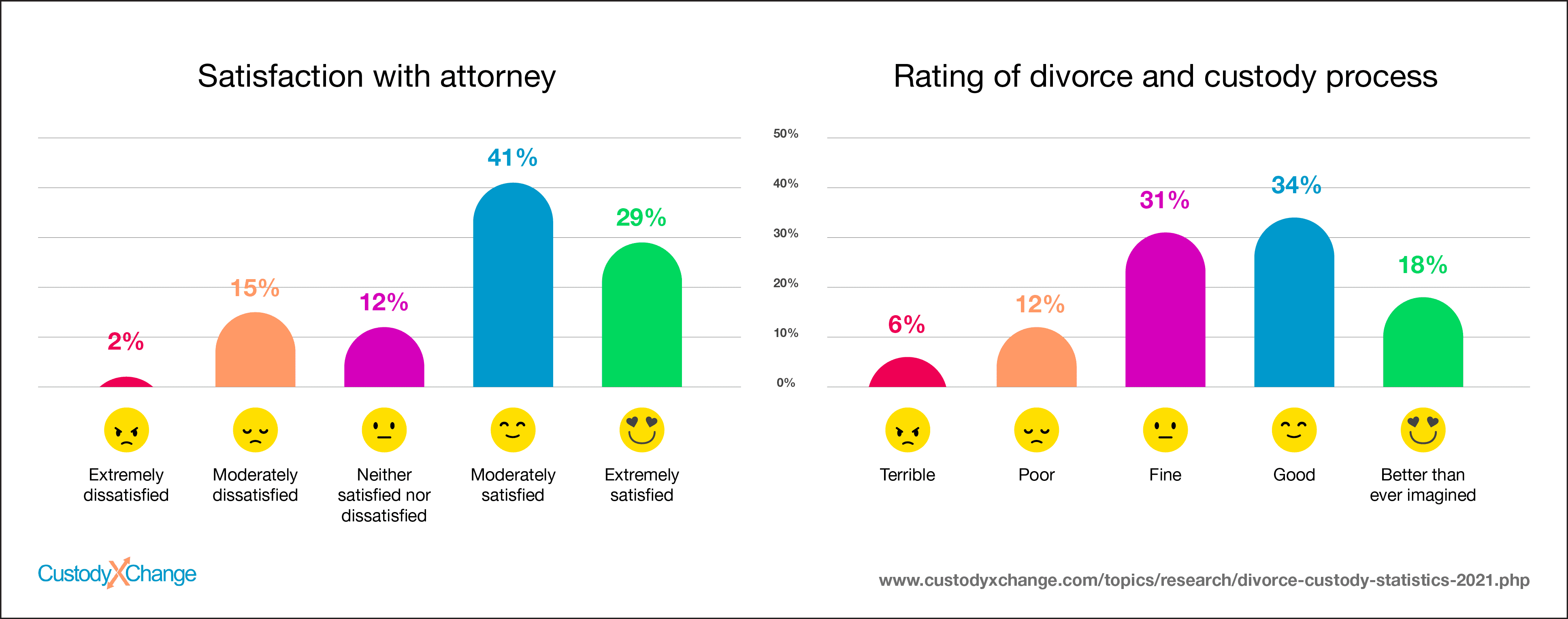
Download: PNG | JPG; Use image with attribution
The median time to resolve a case was eight months, from the start of negotiations to the final ruling. The median cost was $12,000. This included fees paid to attorneys, mediators and the court, but not child support, spousal support or division of assets.
In total, 79% of respondents reached a custody settlement. These parents reported less dissatisfaction with their case outcome and less maladjustment by their children.
More data on settlements
| Settled cases | Non-settled cases |
|---|---|
| Median time of 7 months | Median time of 13 months |
| 13% extremely or moderately dissatisfied with case outcome | 26% extremely or moderately dissatisfied with case outcome |
| 14% of kids adjusted not well at all or only slightly well | 27% of kids adjusted not well at all or only slightly well |
Of the 78% of all cases that resulted in joint physical custody, nearly half had parents split their time with the children evenly.
The vast majority of cases (93%) tried an alternative method of dispute resolution — often more than one. Slightly more than half of all respondents used mediation. Other popular methods included parenting coordination, cooperative law and collaborative law (47%, 46% and 42% respectively). Thirty-five percent of parents used arbitration.
*Many courts require parents in custody cases to attempt ADR unless the case has a settlement ready or involves domestic violence. The proportion of parents who settled without ADR was around 70% whether or not respondents had a low income. This suggests that reasons for opting out of ADR were similar between the two groups.
Download the spreadsheet of survey results (July 2021).
